First and Second Manassas: Blooded Plains
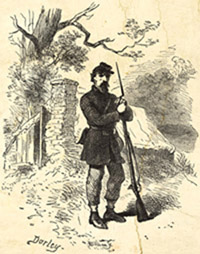


If it wasn’t quite the war’s first battle, it was surely going to be the biggest; and thousands of gung-ho soldiers on each side expected it to be the last. Experienced military men—such as Lincoln’s aging General-in-Chief Winfield Scott—knew better. Still the nation’s reigning military hero at the age of seventy-four, Scott had advocated a slow strangulation of the South, rather than a risky attempt at a quick fix. But military exigencies were no match for political and popular pressure. Newspapers across the North were already demanding that the Rebels be crushed. The New York Tribune was blaring the headlines: forward to richmond! forward to richmond! Influential publisher Horace Greeley insisted that the national army should prevent the new Confederate Congress from convening there on July 20. Equally aggressive-minded Southerners insisted that any Federal thrust be met headlong, and naturally, blunted.
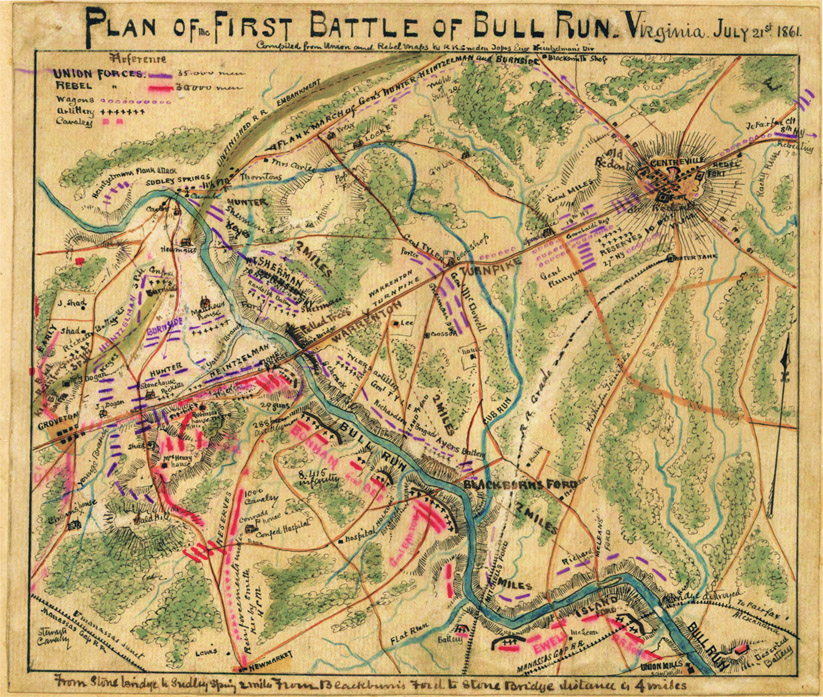
Map of the First Battle of Manassas, also called Bull Run
And so on July 16, 1861, crisply uniformed, 42-year-old brigadier general Irvin McDowell set out from northern Virginia with a raw army of 35,000 with which to attack Brigadier General P. G. T. Beauregard’s equally green army of 22,000 Confederates laying in wait behind a muddy Virginia stream called Bull Run. The polished McDowell was a Mexican War veteran and an 1838 graduate of West Point, where he had also spent four years teaching cadets tactics. Now he would find out if green volunteers could carry out his orders on a battlefield. Winfield Scott, for one, doubted it.
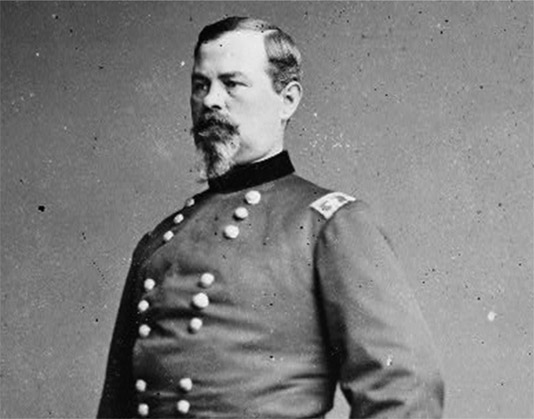
General Irvin McDowell
McDowell’s opponent was an old West Point acquaintance who had finished second, compared to his 23rd, in a class of 45.
Beauregard—who had resigned as superintendent of West Point in January before directing the Rebel attack on Fort Sumter—was already a hero across the South, and a much-hated villain in the North. Deployed to protect the vital rail junction at Manassas, Beauregard’s army counted only about 21,000. Another 12,000 Confederates, however, under General Joseph E. Johnston, were within reinforcing distance in the lower Shenandoah Valley. McDowell was counting on Major General Robert Patterson’s small army to keep Johnston where he was.
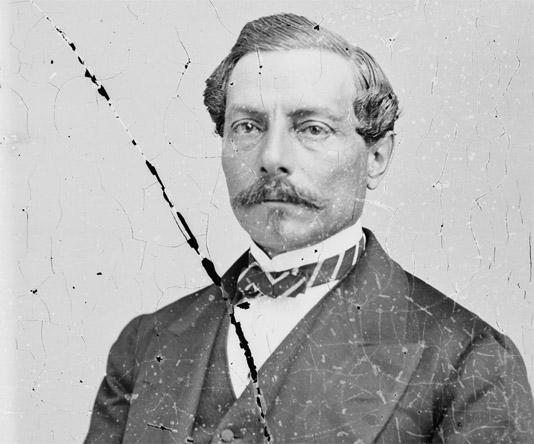
General P. G. T. Beauregard
Crossing Bull Run creek before dawn on July 21, McDowell opened the battle with an attack on the left of Beauregard’s long lines. Each side sent in reinforcements, but the Rebel line caved in, sending Confederates south across a stream and up a rise called Henry House Hill. Blue-clad regiments followed, pressing Bernard Bee’s brigade. Here, however, the Confederates stiffened, spurred on by the appearance of Brigadier General Thomas J. Jackson’s supporting brigade on the hill’s far side. Minutes before his own death, Bee bellowed the words that would make a legend: “Look! There is Jackson standing like a stone wall! Rally behind the Virginians!”
For two hours, McDowell’s Yankees marched up Henry House Hill into the teeth of a desperate Confederate defense. Robert Patterson had not, as it happened, prevented Johnston’s escape, and the infusion of his Rebel troops gradually turned the tide of battle. Late in the afternoon, Johnston and Beauregard took to the offense, launching a stunning blow against the tiring Yankees on McDowell’s left flank. That was all it took. The frustrated Federals took to their heels, retreating back across Bull Run and onto the Warrenton Turnpike. Panic followed, and McDowell’s army fled all the way back to Washington, D.C. The shocking victory cost the Confederates 387 killed and some 1,600 wounded. McDowell lost 460 men killed, 1,100 wounded, and another 1,300 missing.
In the wake of the debacle, Walt Whitman thought of Abraham Lincoln, whose young administration had been saddled with such crushing news, and wrote with admiration:
The president recovering himself, begins that very night—sternly, rapidly sets about the task of reorganizing his forces, and placing himself in positions for future and surer work. If there were nothing else of Abraham Lincoln for history to stamp him with, it is enough to send him with his wreath to the memory of all future time, that he endured that hour, that day, bitterer than gall—indeed, a crucifixion day—that it did not conquer him—that he unflinchingly stemm’d it, and resolv’d to lift himself and the Union out of it.
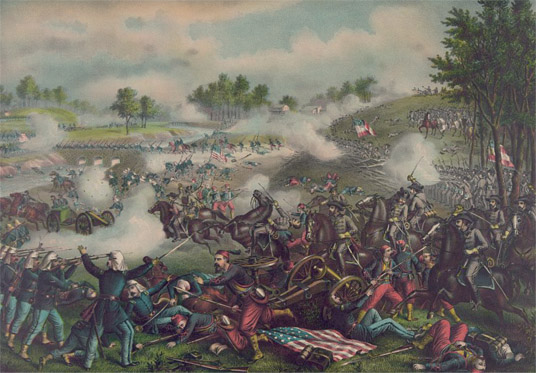
The first Battle of Bull Run

The strategic situation in the east hadn’t changed much 13 months later, when armies of blue and gray met at Manassas for a rematch. Early that summer, George McClellan had driven his grand, new Army of the Potomac to the gates of the Confederate capital before a change in Confederate command, heavy rains, and McClellan’s own demons conspired to push his befuddled army all the way back down the Virginia Peninsula.
Exasperated with the timid and difficult McClellan, Abraham Lincoln relieved the general of his army and assigned two of its corps to Major General John Pope, a 40-old West Pointer who had made a name for himself with a couple of minor victories on the Mississippi.
Pope spent most of August awaiting the arrival of McClellan’s men and shifting his own 50,000 troops around central and northern Virginia in response to Robert E. Lee’s movements north. Failing to detect Stonewall Jackson’s lightning march past his right flank, Pope reacted only after Jackson defeated Nathaniel Banks at Cedar Mountain, cut the Orange and Alexandria rail line at Bristoe, and sacked the Union supply base at Manassas Junction. Marching his 65,000 men northeast up the Warrenton Turnpike, Pope discovered Stonewall Jackson’s 24,000 Confederates dug into an abandoned railroad bed in a wood north of Manassas. On August 29, Pope—failing to concentrate his forces properly—pitched into Jackson’s in a series of attacks, all of which were repulsed. Finally, he launched Major General Fitz John Porter’s command at Jackson’s right, only to find James Longstreet’s newly arrived corps entrenched there.
The following day, Pope renewed his attacks with the same results, until Longstreet, followed by Jackson, ordered massive counterattacks. Pope’s army folded up, and in an eerie repeat of the previous year’s fight here, retreated east up the turnpike behind a solid rear-guard defense. Lee’s victory cost him 9,200 casualties, including nearly 1,500 killed and 7,600 wounded. Pope’s losses amounted to 1,724 killed, 8,372 wounded, and nearly 6,000 missing or captured. The revolving door atop the Army of the Potomac whirled again, spinning Pope all the way to The Plains and bringing George McClellan back for another tour.
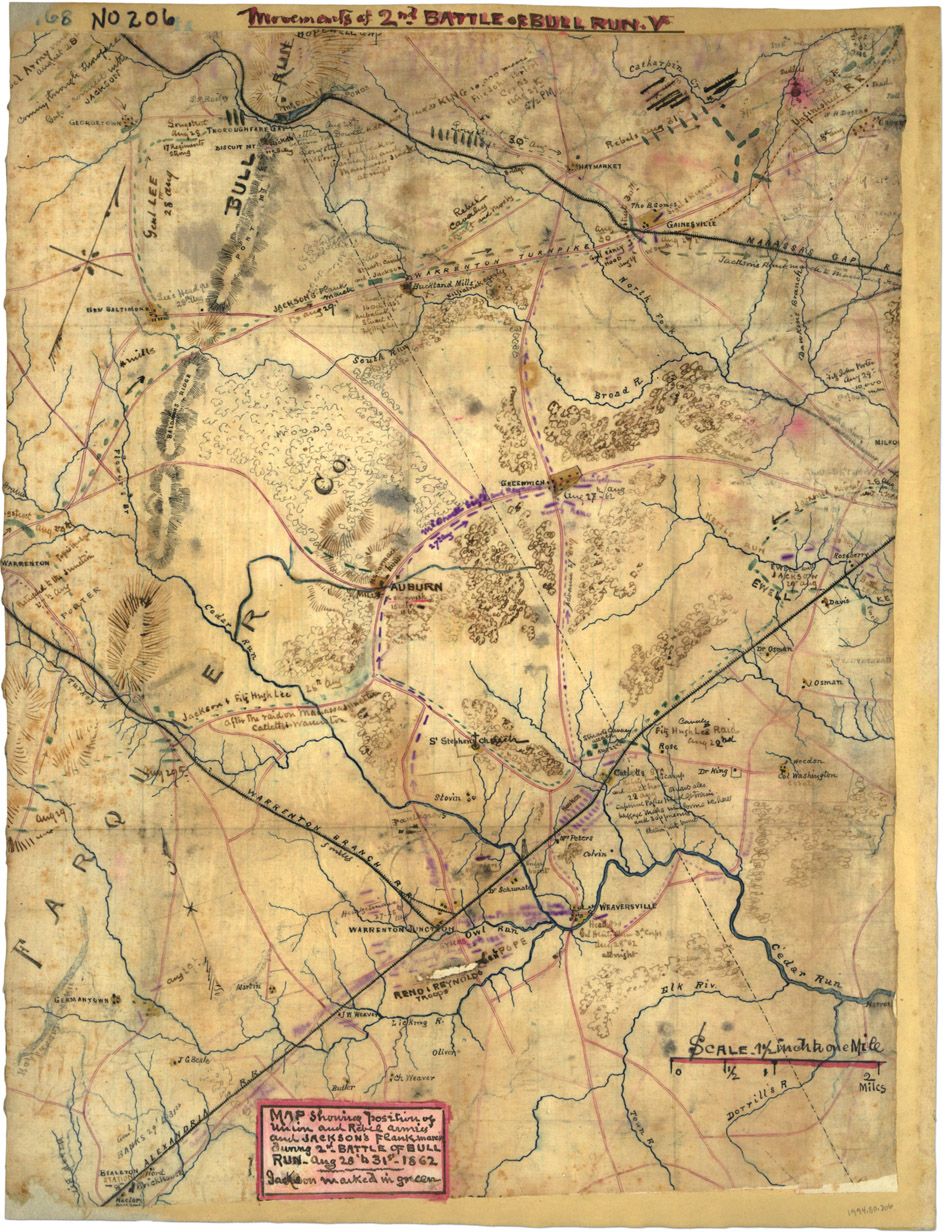
Map of the Second Battle of Manassas
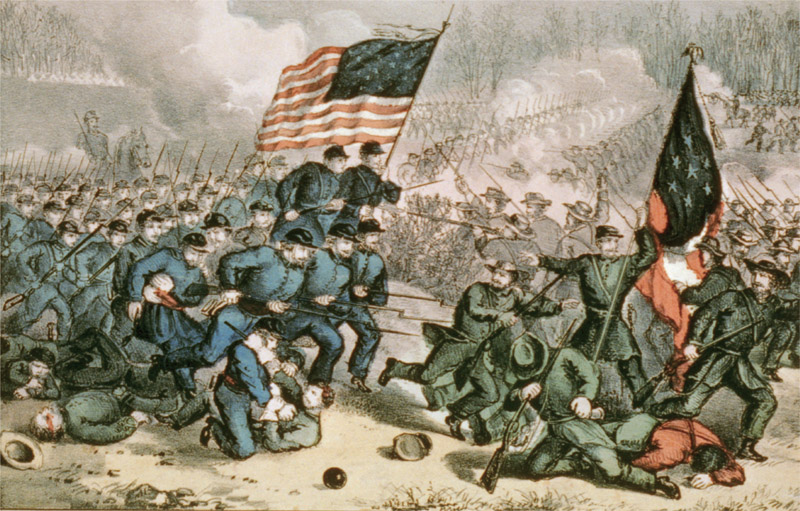
Second Battle of Bull Run, August 29, 1862
Ben Lomond Historic Site
10311 Sudley Manor Dr.
Manassas, VA
(703) 367-7872
This home was built in the 1830s and sustained considerable damage during the battles at Manassas. During the first battle, it was used as a hospital. On the walls, you’ll still see graffiti messages from wounded soldiers.
Brandy Station Battlefield
19484 Brandy Rd. (Graffiti House)
Brandy Station, VA
(540) 727-7718
www.brandystationfoundation.com
The biggest cavalry battle ever fought on this continent took place at Brandy Station, Virginia, on June 9, 1863, when Major General Alfred Pleasanton’s Yankee troopers piled into Major General J. E. B. Stuart’s Confederate camp. Some 17,000 horsemen took part in the daylong affair, which ended in Confederate victory. Stuart, however, had been surprised and fought to a standstill—an indication of the vastly improved Federal cavalry.
Today the Brandy Station Foundation (which, along with the Civil War Preservation Trust [CWPT], owns the preserved sections of the original battle site) maintains and operates the battlefield with the help of donations, grants, and fund-raisers. A recent success here was the CWPT purchase of a small but crucial 18.9-acre section of the original battlefield.
Whether by driving tour or prearranged guided tour (Apr through Oct), there is much to see here today, starting with the Graffiti House. In this building, soldiers from each side scrawled messages or their names here while recovering from wounds. The building also serves today as a museum and park visitor center, offering exhibits, information, tours, and lectures.
The John Singleton Mosby Museum and Education Center
173 Main St.
Warrenton, VA
(540) 351-1600
The John Singleton Mosby Museum and Education Center tells the story of Colonel John Mosby and the county from the 1850s through 1880.
The building now known as Brentmoor, the Spilman-Mosby House was built in 1859 by Judge Edward M. Spilman. Spilman sold the house to former Partisan Ranger John Keith, who in turn sold it to Mosby, who had used Warrenton as a base of operations for much of the war. Mosby, in turn, sold the house to another Confederate veteran, longtime friend Eppa Hunton. The building is now on the National Register of Historic Places.
Liberia Plantation House
8601 Portner Ave.
Manassas, VA
(703) 368-1873
www.ci.manassas.va.us/index.aspx?nid=221
Once a thriving plantation with as many as 90 slaves, Liberia was used by Brigadier General P. G. T. Beauregard as a headquarters during the summer of 1861. A year later, Union major general Irvin McDowell made the building his own headquarters, driving the owners, the Weir family, away for the remainder of the war. Call ahead for information.
The Manassas Museum
9101 Prince William St.
Manassas, VA
(703) 368-1873
The 7,000-square-foot Manassas Museum is the hub of all things historical in Manassas, including a number of small Civil War sites not part of the Manassas Battlefield. Permanent and changing exhibits and videos tell the story of Northern Piedmont history, with a special focus on the Civil War and its effect on the community. The museum also contains a research library and excellent gift shop. Information about other area sites that fall under the jurisdiction of the Manassas Museum System can also be found here.
You can pick up a brochure that details a walking trail and driving trail connecting many of Manassas’s Civil War sites at the museum or at the historic railroad depot, or log on to www.civilwartrails.org to view an interactive map and pick up some tips for organizing your visit. On the same Web site, you’ll also find a guide to the Route 50 corridor and sites in Warrenton and Fauquier County.
The museum is open year-round and is wheelchair accessible.
Manassas National Battlefield Park
651 Sudley Rd. (visitor center)
Manassas, VA
(703) 361-1339
For now, at least, only the ghosts of the men who died here occupy the battlefields of Manassas, quietly guarding the few cannon and monuments that honor their exploits. Outside these serene plains wait the land-grabbing minions of modern society, ready to spring onto this prime real estate and plant yet more strip malls and condominiums. Perhaps no major Civil War site faces the squeeze of encroaching “civilization” quite like Manassas National Battlefield does. It is surrounded by suburban sprawl, which, in places, extends to the very edge of its original breastworks.
Despite the ever-present threat outside its boundaries, this 5,000-acre park looks and feels much the same (aside from one very busy, four-lane intersection) today as it did 140 years ago. Much of it feels secluded from the 21st century. The recent removal of power lines from the Brawner Farm and partial restoration of the Henry and Thornbury Houses have helped. The park has also added a new picnic area.
Before setting out on a walking tour of the park, visitors will want to check out its small museum, which offers exhibits, a short film, and a helpful electronic battlefield map.
Manassas Railroad Depot
9431 West St.
Manassas, VA
(703) 361-6599
(877) 848-3018
The depot is the town’s de facto visitor center, where brochures and tourist information can be found. It is also the home of the James and Marion Payne Memorial Railroad Heritage Gallery, a combination of exhibits and artifact displays representing the town’s extensive railroad history. Admission is free to the gallery.
Mayfield Earthwork Fort
8401 Quarry Rd.
Manassas, VA
(703) 368-1873
This 11-acre site was constructed by P. G. T. Beauregard’s Confederates during May and June 1861, in anticipation of Union attack. After March 1862, Union soldiers also periodically used the earthworks.
There is an interpretive trail with markers and replica “Quaker guns.” The park is open daily from sunrise to sunset and is free of charge.
The Museum of Culpeper History
803 S. Main St.
Culpeper, VA
(540) 829-1749
If you’re traveling southwest, continue on to Culpeper, another charming Virginia town that’s brimming with Civil War history. From Manassas, it’s about an hour to this town, tucked away in the scenic Blue Ridge Mountains. The Culpeper Museum offers a fantastic overview of the county’s historic past. Located at the entrance to the Culpeper Historic District, this unassuming facility (which was originally known as the Culpeper Cavalry Museum) now focuses on the history of Culpeper County. In addition to impressive indoor and outdoor displays related to Native American and Colonial history, the museum boasts an entire gallery dedicated to the Civil War.
Old Jail Museum
Court House Square
Warrenton, VA
(540) 347-5525
Consisting of two structures built in 1808 and 1823, this beautifully preserved old jail now houses a series of exhibits about the Revolutionary War, Native American history, the Civil War, and local favorite John Singleton Mosby. The Old Jail Museum is free of charge, but donations are welcome.
OTHER POINTS OF INTEREST
Aldie Mill
Aldie, VA
(703) 327-9777
Located just west of Route 15 on U.S. Route 50, the small town of Aldie witnessed the passing of troops on June 17, 1863, as they marched toward Gettysburg. Mosby’s men also fought near Aldie Mill in 1861. The early-19th-century mill is open for free tours on Sun, Apr through Oct. Tours are free, but donations are welcome.
Blackburn’s Ford
North of Manassas off Rte. 28
Soldiers got their first taste of battle on this ford on Bull Run. On July 18, Union troops approached the ford during a reconnaissance trip only to find Confederate forces waiting. The Southern forces stood their ground, setting the tone for the major battle that was about to transpire.
Marshall, VA
Mosby’s raiders fought and finally, on April 21, 1865, disbanded in this small town west of Manassas and Haymarket. Confederate loyalists silently cheered here as they watched Stonewall Jackson pass through on his way to the Battle of Second Manassas.
Piedmont Station
Delaplane, VA
It was at this train station west of Manassas that soldiers from the Army of the Shenandoah boarded a train on their way to Manassas Junction on July 19, 1861. Colonel Thomas J. Jackson was among the travelers; two days later, he would earn his nickname “Stonewall” at the First Battle of Manassas. The troops’ 30-mile trip east is believed to be the first instance in which troops were moved into combat on railroad.
Rectortown, VA
Another small town in this Civil War history–rich corner of Virginia, it was here that General George McClellan was relieved of his command of the Union forces and replaced by General Ambrose Burnside in November 1862 after McClellan’s failure to destroy Lee’s army at Antietam.
Signal Hill
Manassas Park, VA
This small, independent town just outside of Manassas was once home to a Confederate signal station. On July 21, 1861, a Confederate signal officer named E. P. Alexander first spotted a Union cannon and forces closing in on the Confederate line. He sent a signal to Nathan “Shanks” Evans, who held the command near the Run Bridge. It is believed to be the first time “wigwag” signaling—a system of coded flag movements—was used during combat.
Thoroughfare Gap
West of Manassas, off I-66
Confederate forces led by Stonewall Jackson traveled through this mountain pass on their way to fight in the Second Battle of Manassas. Confederate General James Longstreet followed with his troops, but they were met with resistance from Union forces under the command of General James B. Ricketts. The Union forces failed to stall Longstreet’s advance, thus enabling the Second Battle of Manassas to take place. You can still see the ruins of Chapman’s Mill, a Confederate meat-curing and distribution center, which witnessed much of the battle.
Warrenton Cemetery
Warrenton, VA
In this cemetery, located across the street from the visitor center, there’s a memorial honoring the more than 600 Confederate soldiers who died in the region’s makeshift hospitals. It’s also home to Mosby’s grave.
| Bennett House Bed & Breakfast | $$–$$$$ |
9252 Bennett Dr.
Manassas, VA
(800) 354-7060
If you’re looking for a place to stay in Manassas, an area increasingly threatened by urban sprawl, your options are largely confined to national and international chain hotels. For something a little more unique, however, Bennett House is your best bet. The impeccably kept bed-and-breakfast offers tranquil, home-style comfort (as well as antiques-filled rooms, central air, and in-room cable and VCRs) in the heart of Old Town Manassas. Mornings are memorable, as innkeepers Jean and Curtis Harrover offer a full country breakfast. The inn has just two rooms, so visitors should make a reservation well in advance.
| Black Horse Inn | $$$–$$$$ |
8393 Meetze Rd.
Warrenton, VA
(540) 349-4020
If you don’t mind a bit of a drive from the battlefield, treat yourself to a stay at the award-winning Black Horse Inn in Warrenton, about 30 minutes west of Manassas—a town with unspoiled scenery and Civil War attractions of its own as well. The circa-1850 mansion served as a hospital during the Civil War and was frequently visited by the Black Horse Cavalry. Today, the nine-room inn is among the finest in northern Virginia. Many of its rooms are outfitted with canopy beds, gable ceilings, and Jacuzzi and antique claw-foot tubs; stables are even available for visiting horses. Breakfast and tea service is also included in the room rate.
| Country Inn & Suites | $$$$ |
10810 Battleview Pkwy.
Manassas, VA
(703) 393-9797
We’ve done our best to avoid chain accommodations, but in a region where national brands hold sway, it’s good to include one of the top players. Country Inn & Suites provides an exceptional value—pleasant amenities, including a complimentary and substantial breakfast, an indoor pool, and whirlpools in many of the rooms—and a great location between the Manassas National Battlefield Park and Old Town Manassas.
| Fountain Hall Bed and Breakfast | $$$–$$$$ |
609 S. East St.
Culpeper, VA
(540) 825-8200
(800) 298-4748
While Culpeper is a bit of a drive from the sites of Manassas and Warrenton, you’re in for a treat if you make the trip. Steve and Kathi Walker’s Fountain Hall is truly one of a kind. Built in 1859 in the heart of Culpeper, this grand Colonial Revival, complete with glorious walnut staircase, is within walking distance of the Culpeper Museum, National Cemetery, and the fine dining offered downtown. Civil War buffs can easily walk to Brandy Station or the Cedar Mountain area, while the battlefields of Manassas, Fredericksburg, and Spotsylvania are just a short drive away. For old-fashioned relaxation, Fountain Hall features an extensive library and lawn games.
| The Grey Horse Inn Bed & Breakfast | $$$–$$$$ |
4350 Fauquier Ave.
The Plains, VA
(540) 253-7000
(877) 253-7020
Innkeepers John and Ellen Hearty welcome guests to this wonderful hunt country retreat in the town of The Plains. Confederate troops marched through the town—amid spies working for both sides—in August 1862 as they ventured to Manassas. There are six bedrooms, including one two-room suite, tastefully decorated to reflect the spirit of this 1880sera mansion. The picturesque grounds and gardens form the perfect setting to enjoy a book or savor a cup of tea. True to its name, the inn is also popular among horse lovers who flock to The Plains for Virginia’s Gold Cup steeplechase race and other equestrian events.
| Poplar Springs, the INN Spa | $$$$ |
9245 Rogues Rd.
Casanova, VA
(540) 788-4600
(800) 490-7747
What could be more romantic than a town called Casanova? Secluded, charming, and outfitted with one of the region’s most inviting spas, Poplar Springs is a fitting match for the town in which it’s located. The inn is nestled on 200 private wooded acres, with hiking and biking paths that lend to exploration on foot. Because it’s a popular choice for stressed-out Washingtonians eager for an escape, the inn goes overboard to help you relax: think breakfast in bed, prompt valet service, and highly attentive service. While much of the 22-room property is modern construction, the historic Manor House now houses a fine-dining restaurant known for its roaring fire, soothing piano music, and fine cuisine. Don’t be surprised to see sweetbreads, venison, elk, and other unusual items on the menu.
| Westfields Marriott | $$$$ |
14750 Conference Center Dr.
Chantilly, VA
(703) 818-0300
For luxury accommodations and even a quick round of golf or spa treatment between Manassas and Dulles Airport, this AAA-Four Diamond designated Marriott property is a fine choice. Unlike many of our other recommendations, this 327-room resort is sleek and modern, equipped with modern, business-traveler-friendly amenities like wireless Internet, but also furnished with touches of art and antiques. There’s a Fred Couples–designed golf course on the premises, along with a high-end spa.
RESTAURANTS
| Carmello’s & Little Portugal Restaurant | $$$ |
9108 Center St.
Manassas, VA
(703) 368-5522
It may be surprising to find one of the Washington, D.C., metropolitan area’s premier Portuguese restaurants in the commuter town of Manassas, but many regional residents with discerning palates have found their way to Carmello’s since it opened. On the menu, you’ll find a blend of classic northern Italian pasta dishes, along with Portuguese creations like bife pimenta (filet mignon served in port wine with cracked pepper) and vierias (shrimp, scallops, lobster, and artichoke hearts sautéed in garlic and white wine sauce). Pair up your dinner with a bottle of Alvarhino or another Portuguese wine. It’s located on Old Town Manassas’s primary shopping street, perfect for an after-dinner stroll.
| City Square Café | $$ |
9428 Battle St.
Manassas, VA
(703) 369-6022
This family-friendly restaurant has served comfortable, casual fare to locals and visitors for more than 30 years. Owners Robert and Susana Barolin serve Mediterranean dishes like chicken parmesan and veal Marsala, along with standard American classics like prime rib and shrimp scampi. Showcasing the flavors of the Barolins’s native Uruguay, you’ll also find an extensive selection of South American wines on the wine list, along with empanadas on the menu.
| Claire’s at the Depot | $$$ |
65 S. Third St.
Warrenton, VA
(540) 351-1616
As the Washington, D.C., metropolitan area continues to expand to the west, once-sleepy towns like Warrenton begin to attract more urban-minded residents, along with high-quality restaurants such as this one. On the menu, you’ll find eclectic, modern cuisine. The turn-of-the-century depot in which it’s located shows off the flavors of the town’s railroad past. Modern twists and regional classics frequently show up on the menu, like scrumptious she-crab soup and oysters served in a cornmeal crust. Dishes are flavorful, crafted with local produce and seasoned with fresh herbs grown on-site, and vegetarians won’t be disappointed by the meatless selections. If you dine here in the spring or summer, ask to be seated on the glorious outdoor patio among the seasonal flowers and fountains.
| Foti’s Restaurant | $$$ |
219 E. Davis St.
Culpeper, VA
(540) 829-8400
New to the Culpeper restaurant scene, Foti’s has quickly become known as one of the area’s best eating establishments. This is not a restaurant to walk into straight from a battlefield; it is a first-class, fine-dining house perfect for those looking for superb food and a relaxing night on the town. Wondering about the name? It’s a childhood nickname that co-owner Frank Maragos used to answer to, setting the tone for a friendly, familiar dining experience. Main courses include such flavorful creations as crispy seared Tasmanian salmon and lamb three ways. Reservations are highly recommended.
| Okra’s Louisiana Bistro | $$ |
9110 Center St.
Manassas, VA
(703) 330-2729
Even discerning Cajun diners take a shine to Okra’s, a colorful, friendly eatery in Old Town Manassas. Munch on appetizers like alligator bites and fried okra as you wait for your food and sip an Abita beer or Hurricane. For the main course, you can’t go wrong with the jambalaya, teeming with andouille, shrimp, and tasso ham, or the zesty crawfish étoufée, flavorful and bursting with vegetables and spices. The restaurant is also a lively place for nightlife with frequent live music acts. It stays open late, too.
| The Rail Stop Restaurant | $$$ |
6478 Main St.
The Plains, VA
(540) 253-5644
It’s no wonder that railroad-themed restaurants are popular in this part of Virginia; the steel tracks played an integral role in the histories of many of the Commonwealth’s small towns and cities. In the tiny hamlet of The Plains, the Rail Stop is the place to go for your urban restaurant fix—and possibly even a brush with a celebrity. (Actor Robert Duvall lives nearby and was once co-owner of the restaurant.) Stop in at lunchtime for a satisfying grilled salmon BLT topped with pancetta, arugula, and basil aioli or linger over a tantalizing dinner of pan-seared scallops accompanied by mushroom risotto and smothered in a garlic cream sauce or fresh gnocchi paired with Italian sausage, artichokes, roasted peppers, tomatoes, onions, and fresh mozzarella.
| Sweetwater Tavern | $$ |
14250 Sweetwater Lane
Centreville, VA
(703) 449-1100
www.greatamericanrestaurants.com
Locals love Sweetwater Tavern—a Fairfax, Virginia–based restaurant with a few locations in the Washington, D.C., metro area, including this one that’s just north of Manassas. It’s always hopping, and the food, service, and ambience are consistently good. Sample the house-made beers and munch on Southwestern creations like Tex-Mex egg rolls and spicy bean-cheese-guacamole dip, then move on to crowd-pleasing main courses like crispy chicken tenders, juicy burgers, and barbecued ribs. If you’re shopping for evening entertainment, you’re also likely to find live music and a crowd that appreciates it.
| Virginia Barbeque | $$ |
9952 Liberia Ave.
Manassas, VA
(703) 369-4227
If you’re looking for great barbecue in the town of Manassas, this is the place for it. Don’t let the plain strip mall in which it’s located fool you; it’s well known in the area for producing fabulous meats in the Virginia, North Carolina, or Texas tradition. Because you’re in Virginia, we’d steer you to the specialty: Virginia-style pulled pork, slathered in the spicy tomato-based sauce for which the Old Dominion is known. The restaurant also does an admirable job with traditional barbecue accompaniments, like tangy coleslaw, perfectly seasoned baked beans, and freshly prepared hush puppies.